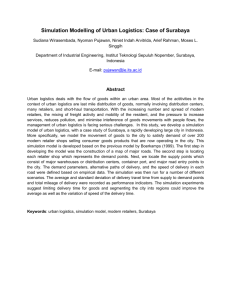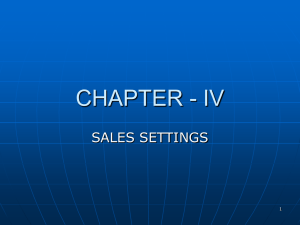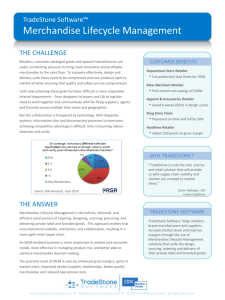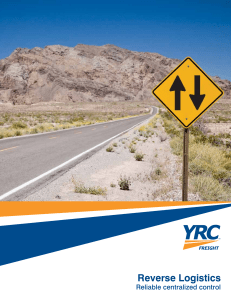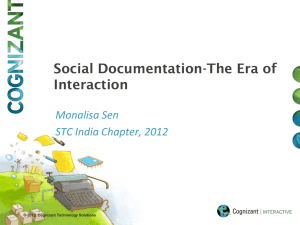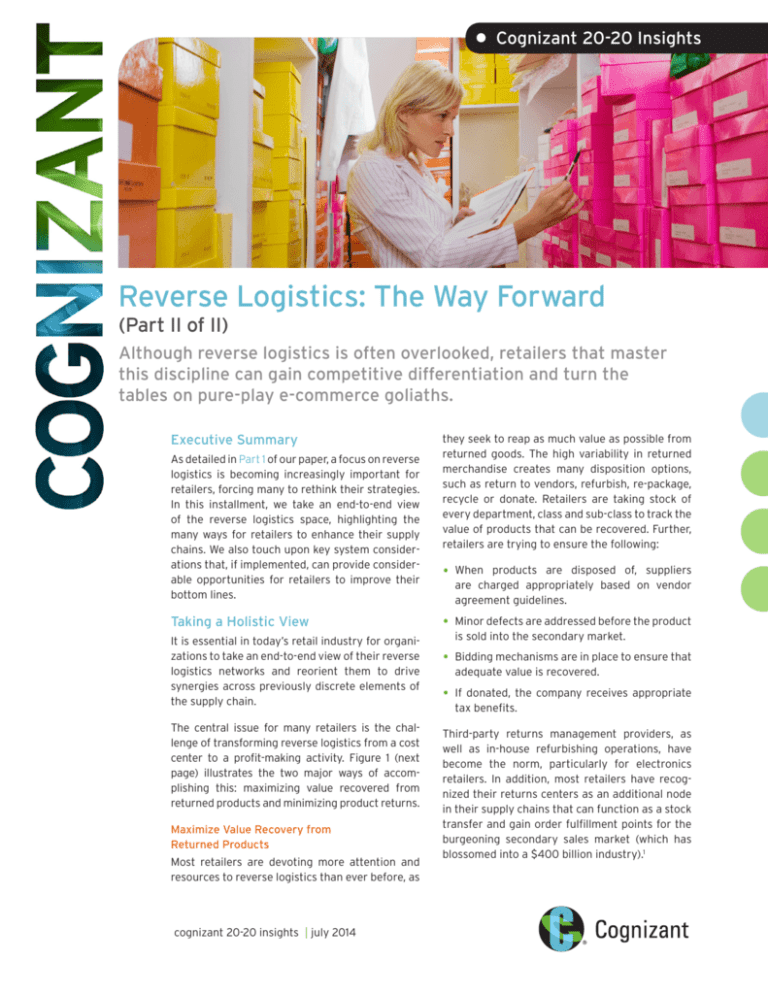
• Cognizant 20-20 Insights
Reverse Logistics: The Way Forward
(Part II of II)
Although reverse logistics is often overlooked, retailers that master
this discipline can gain competitive differentiation and turn the
tables on pure-play e-commerce goliaths.
Executive Summary
As detailed in Part 1 of our paper, a focus on reverse
logistics is becoming increasingly important for
retailers, forcing many to rethink their strategies.
In this installment, we take an end-to-end view
of the reverse logistics space, highlighting the
many ways for retailers to enhance their supply
chains. We also touch upon key system considerations that, if implemented, can provide considerable opportunities for retailers to improve their
bottom lines.
Taking a Holistic View
It is essential in today’s retail industry for organizations to take an end-to-end view of their reverse
logistics networks and reorient them to drive
synergies across previously discrete elements of
the supply chain.
The central issue for many retailers is the challenge of transforming reverse logistics from a cost
center to a profit-making activity. Figure 1 (next
page) illustrates the two major ways of accomplishing this: maximizing value recovered from
returned products and minimizing product returns.
Maximize Value Recovery from
Returned Products
Most retailers are devoting more attention and
resources to reverse logistics than ever before, as
cognizant 20-20 insights | july 2014
they seek to reap as much value as possible from
returned goods. The high variability in returned
merchandise creates many disposition options,
such as return to vendors, refurbish, re-package,
recycle or donate. Retailers are taking stock of
every department, class and sub-class to track the
value of products that can be recovered. Further,
retailers are trying to ensure the following:
• When
products are disposed of, suppliers
are charged appropriately based on vendor
agreement guidelines.
• Minor defects are addressed before the product
is sold into the secondary market.
• Bidding mechanisms are in place to ensure that
adequate value is recovered.
• If donated, the company receives appropriate
tax benefits.
Third-party returns management providers, as
well as in-house refurbishing operations, have
become the norm, particularly for electronics
retailers. In addition, most retailers have recognized their returns centers as an additional node
in their supply chains that can function as a stock
transfer and gain order fulfillment points for the
burgeoning secondary sales market (which has
blossomed into a $400 billion industry).1
Reverse Logistics Management: A Virtuous Cycle
Increased
multi-chann
hannnel
retuurnss
l
Va
s
tics
Netw
Integ ork
rat
ion
imi
Increassed
producct saffety
regulations
rs
turn
&
Returns
Management
Solution
cto
Re
duct ivi ty
c
ct
Pro
P
Fa
Flexibility
ze
ci
ize
en
aly
Max
lu
du
en
Scalability
iim
ro
lu
Min
y
BI
Inf
R
ec
r
ove
Inf
g
ue
ors
An
Increased
edd
transportaatiion
c os t
g
F
t
ac
Stringeent
and changin
ch
ng
compliaannce
in
n
Returns as
revenue
ue
oppoort
rtunity
Figure 1
To bridge the gap with the aforementioned objectives, retailers are building capabilities, such as:
• Integration
shortcomings: Current solutions
focus on individual aspects of the reverse
supply chain and tend to optimize these
processes.
• Increased integration across the supply chain,
in which data collected at the returns desk and
returns consolidation centers is shared across
the supply chain, including merchants, vendors
and transportation.
• A focus on CRM solutions, BI and analytics to
garner meaningful trends from returned merchandise.
Minimize Product Returns
As discussed in Part 1, trends such as omnichannel shopping have resulted in an increasing
rate of returns. Retailers are now attempting to
reduce the overall volume of returns by using CRM
solutions and analytics to understand the major
cause of returns. Retailers are also providing
information to their supply chain partners,
including vendors, manufacturers and transportation providers, for timely action. By predicting
and moving returned freight from areas of lower
sales to higher sales, retailers are avoiding
unnecessary markdowns and subsequent loss of
revenue. Vendors and manufacturers are using
this data to improve products and reduce returns.
• Scalability: This is a particular issue for large
retailers.
• Repairs and refurbishing: An additional concern is auction mechanisms for secondary
markets.
A Complete Reverse Logistics
Management Solution
An effective solution for returns center
management will encompass industry-leading
capabilities that enable a retailer or manufacturer to drive efficiencies and maximize the
value recovered from returns. Figure 2 (next
page) depicts the key features and functionalities included in our solution. A complete reverse
logistics management solution should contain the
following functionalities:
• Basic
warehouse management: Core WMS
functionalities include receiving, inventory
control, quality assurance and shipping.
• Enhanced
value recovery: Modules are
required for refurbishment, repairs, tracking of
retail supplies (such as used or returned bags,
papers, etc.) and end-of-life/defective IT assets,
such as servers, computers, price scanners,
etc. Functionality is also required to fulfill basic
replenishment and order fulfillment needs.
Inherent Issues with Existing Reverse
Logistics Solutions
Most available solutions fall short of retailers’
reverse logistics needs in one or more of the
following areas:
cognizant 20-20 insights
2
An Optimal Approach to Returns Management
3PL Services
Customer Service/Reclamation Desk
Returns Value
Platform
Returns Center Management
Store Return Management
Returns Center Management
Store Operations
Value Recovery
Customer
Service Desk
Store Backroom
Processing
Merchandise Transfer
Claims Management
Supplies Tracking
Credit Processing
Handlingg Used
IT Assets
Depot
p Repair
p
Management
Inventory
Management
Auditing
QA, Setup &
Configuration
Intuitive Inspection
Module
Disposition
Financials
RMA Management
Merchandise
Fulfillment
Recall Management
Disposition Setup
Printer
Core WMS Capabilities
T h
Touchscreen
Desktop
Tracking Returns
Receiving
EDI Enablement
Shipping
ASN Receiving
Freight Movement
Analytics & BI
Mobile Devices
Handhelds
Sourcing &
Procurement
Merchandise
Auction
Supplies/Assets
Auction
Hauling & Waste
Stream Management
Sourcing
Scanner
Scanner
External Systems — Retailer’s or CPG Corporate Systems Linkage to Value Platform
Store Systems
Master Data
Planning Systems
POS
Vendor Master
Store Financials
Item File
Order Management
System
Transportation
System
Yard Management
Systems
Store Inventory
Compliance
Replenishment
Supplier System
Financial System
Operational Systems
Figure 2
• Tracking and returns: EDI and ASN capabilities
should provide enhanced tracking of returned
merchandise. Minimizing returns will be
enabled through meaningful mining of returns
data, supported by strong BI and analytics
capabilities. The solution should also address
basic reverse logistics needs, such as warranty
and claims management, recall management
and an inspection module for repair and maintenance.
• Integration: The returns management solution
should easily integrate with master data
from enterprise systems of record, as well as
planning and other peripheral systems, such as
transportation, finance and CRM solutions for
seamless operation.
Further, the solution should be scalable to manage
the high volumes of data typical of large retailers.
A modular approach for the product will ensure
that retailers can customize and use functionalities based on their specific business models.
Stretching functionalities across devices, from
handheld to desktop-based systems, will only
enhance operational efficiency.
cognizant 20-20 insights
Looking Ahead
To improve the reverse logistics process, it is
important to first examine the “as-is” state. During
this stage, it would be prudent to answer questions
such as: How many units are being returned? Are
there any spikes or trends in the returned goods?
What is the reason for returns? What happens to
the product after it is returned? What is the total
cost incurred in handling returns? Do I outsource
my returns to a third-party provider?
Armed with answers to these questions and more,
companies can identify areas of hidden profits
and enhancements. By addressing the key points
referenced in this series, organizations can refine
their reverse logistics process, while minimizing
liabilities and yielding tangible benefits in productivity and the bottom line.
With growing e-commerce purchases, retailers
face return rates that have increased multifold.
Categories such as online apparel are said to
experience return rates in excess of 30%. Coupled
with increased environmental regulations, organizations must renew their focus on efficiently and
effectively managing the returns processes.
3
Our returns management framework can help
retailers define processes to maximize value
recovery from returned goods and reduce
returns through an effective feedback channel.
The framework encompasses processes from
stores’ service desks to returns centers, enabling
higher value recovery through proper disposition of returned items and leveraging of returned
inventory for order fulfillment.
Footnotes
1
Lisa Terry, “Managing Retail Returns: The Good, the Bad, and the Ugly,” Inbound Logistics,
February 2014, http://www.inboundlogistics.com/cms/article/managing-retail-returns-the-good-the-badand-the-ugly/.
About the Authors
Joydip Lahiri is a Senior Consultant within Cognizant Business Consulting’s Retail Practice. He is responsible for projects in supply chain and logistics and has worked with multiple Fortune 500 clients on
defining supply chain and logistics strategy. Joydip holds an M.B.A. from Indian Institute of Management,
Kozhikode. He can be reached at Joydip.lahiri@cognizant.com.
Subhash Anuguthala is a Functional Consultant within Cognizant Business Consulting’s Retail Practice.
His primary areas of work are supply chain and operations. Subhash has worked on multiple warehouse
management systems implementations. He holds a master’s degree in management information systems
from Texas A&M University, as well as an undergraduate degree from Jawaharlal Nehru Technological
University in Hyderabad, India. Subhash can be reached at Subhash.Anuguthala@cognizant.com.
Brian Martin is a Business Analyst within Cognizant Business Consulting’s Retail Practice. Brian is responsible for providing strategic governance for a leading retailer’s international operations and has successfully helped implement a direct-to-customer fulfillment supply chain transformation program for a large
retailer. Brian received his undergraduate degree in information systems with a minor in transportation
and logistics from the University of Arkansas. He can be reached at Brian.Martin@cognizant.com.
About Cognizant
Cognizant (NASDAQ: CTSH) is a leading provider of information technology, consulting, and business process outsourcing services, dedicated to helping the world’s leading companies build stronger businesses. Headquartered in
Teaneck, New Jersey (U.S.), Cognizant combines a passion for client satisfaction, technology innovation, deep industry
and business process expertise, and a global, collaborative workforce that embodies the future of work. With over 50
delivery centers worldwide and approximately 178,600 employees as of March 31, 2014, Cognizant is a member of the
NASDAQ-100, the S&P 500, the Forbes Global 2000, and the Fortune 500 and is ranked among the top performing
and fastest growing companies in the world. Visit us online at www.cognizant.com or follow us on Twitter: Cognizant.
World Headquarters
European Headquarters
India Operations Headquarters
500 Frank W. Burr Blvd.
Teaneck, NJ 07666 USA
Phone: +1 201 801 0233
Fax: +1 201 801 0243
Toll Free: +1 888 937 3277
Email: inquiry@cognizant.com
1 Kingdom Street
Paddington Central
London W2 6BD
Phone: +44 (0) 20 7297 7600
Fax: +44 (0) 20 7121 0102
Email: infouk@cognizant.com
#5/535, Old Mahabalipuram Road
Okkiyam Pettai, Thoraipakkam
Chennai, 600 096 India
Phone: +91 (0) 44 4209 6000
Fax: +91 (0) 44 4209 6060
Email: inquiryindia@cognizant.com
­­© Copyright 2014, Cognizant. All rights reserved. No part of this document may be reproduced, stored in a retrieval system, transmitted in any form or by any
means, electronic, mechanical, photocopying, recording, or otherwise, without the express written permission from Cognizant. The information contained herein is
subject to change without notice. All other trademarks mentioned herein are the property of their respective owners.


